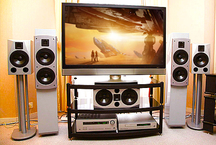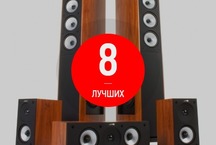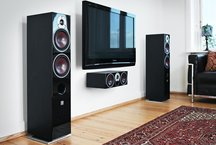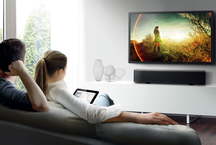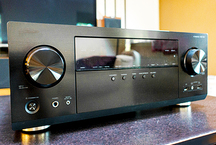Top 15 music centers

Music centers first appeared in our apartments a couple of decades ago.Despite the fact that the “computer + amplifier” bundle is becoming increasingly popular as a source of sound - it is difficult to deny universality - and good old music centers do not lose demand, often connecting with a linear input all with the same PC. A good music center is not only broadband speakers of quite decent quality, but also the ability to play audio from a variety of sources, in the top of which now, of course, USB flash drives and memory cards. But devices with “trays” for several discs are not going to die: the discs themselves can now be considered collectible, and listening to your favorite artist from a licensed CD (and with an autograph on the box) is much more pleasant than a track downloaded from the Internet on a flash drive. In addition, many models acquire support for DVD and video output, turning, in fact, in the “2 in 1” package - connect such a center to the TV and you can get much better sound in comparison with the built-in acoustics without spending on a separate video player or more expensive AV receiver with a set of speakers. In our ranking - the best music centers in 2018-2019, according to reviews of experts and buyers.
Rating of the best music centers in 2018-2019 year - TOP 15
| Category | A place | Name | Rating | Price |
|---|---|---|---|---|
| The best music centers - microsystems | 1 | Pioneer X-EM26-B | 9.6 / 10 | 8 490 |
| 2 | Philips BTM2310 | 9.4 / 10 | 6 105 | |
| 3 | Pioneer X-PM12 | 9.2 / 10 | 13 893 | |
| 4 | Sony CMT-SBT20 | 9.0 / 10 | 6 460 | |
| The best low-cost stereos | 1 | Mystery MMK-915UB | 9.5 / 10 | 7 364 |
| 2 | BBK AMS115BT | 9.4 / 10 | 5 940 | |
| 3 | Mystery MMK-820U | 9.2 / 10 | 9 308 | |
| The best middle class stereos | 1 | Onkyo CS-265 Black | 9.9 / 10 | 21 490 |
| 2 | Pioneer X-CM56-B | 9.7 / 10 | 12 980 | |
| 3 | Philips FX10 | 9.2 / 10 | 9 672 | |
| 4 | LG OM7550K | 9.0 / 10 | 19 620 | |
| The best premium audio systems | 1 | Pioneer XC-P01-S | 9.8 / 10 | 27 490 |
| 2 | Sony MHC-V77DW | 9.3 / 10 | 24 140 | |
| 3 | Denon D-M41 | 9.3 / 10 | 27 990 | |
| 4 | Yamaha PianoCraft MCR-N560 Black | 9.1 / 10 | 44 490 |
The best music centers - microsystems
|
8 490
Pioneer's microsystem is already difficult to call a budget one, but for its money it is undoubtedly the best: a minimalistic and seasoned design, the presence of a CD tray and flash drive entry allows you to listen to your favorite recordings and new items found on the network. Plus, support for Bluetooth 4.0 (A2DP 1.2 / AVRCP 1.4), in the era of smartphones and tablets, becoming a must have for audio.
The acoustics for the microsystem is decent enough: compact speakers draw up to 10 W of RMS, in small rooms providing adequate volume without strong distortion. Forgive us audiophiles, who, at the words "10% SOI", grab at heart. The speakers in the columns are wide-band, 76 mm wide, and their characteristics are chosen weightedly: although they don't have crystal clear tops, which is not surprising (but you can buy some tweeters), the bottoms do not turn into a nondescript bubble, and the middle is quite legible. Equalizer - five-mode, without user correction. Coupled with the additional mode P.Bass it is enough to adjust the sound for themselves. A useful feature of the design is the ability to use the flash drive port to charge mobile phones: if the micro system “settles” in the bedroom as an alarm clock, you will not need to occupy another outlet with a charger. Main advantages:
Minuses:
|
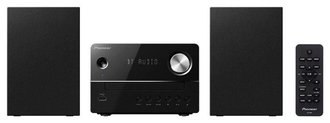 9.6 / 10
Rating
Reviews
Nice and relatively inexpensive good micro system, in a one-room apartment self-sufficient. |
|
6 105
Interesting music center for a relatively small price for small rooms. Although Phillips won in price, it was about as much behind the sound: at the same volume with the Pioneer, it would have to be unscrewed more, and 7.5-watt (again, according to RMS) single-sided speakers, this is clearly not like it.In addition, the characteristics of these speakers themselves, and the design of the phase-inverter housings are more sharpened to the "bottom" (as far as possible for compact acoustics), and the upper middle and HF are pulled out by digital "improvers" in the sound processing path. The columns are noticeably heavier than those of the Pioneer, but with such power, to be honest, there is no tangible benefit from thicker hull walls. Features are standard for microsystems of this class: single-disc tray for CD / MP3, playback of audio from USB-carriers and via Bluetooth, FM-radio. But the developers have refused traditional equalizer presets, now you need to choose numbered sets of those same “improvers” - this method obviously loses in clarity, you have to scroll through the entire set for the first time, choosing the optimal setting for yourself. Main advantages:
Minuses:
|
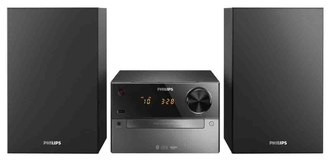 9.4 / 10
Rating
Reviews
Takes up little space. It sounds for the money. Not a 60 watt multiband, of course, but enough for me. On bluetooth the sound goes well. |
|
13 893
Music center with a classic design and equally traditional functionality. For a mini-system, the sound quality and power is simply excellent. And if someone wants more, you can connect a subwoofer. The columns are installed both horizontally and vertically (special self-adhesive feet are included). Reproduces all kinds of CDs. There is a USB connector, but its functionality is limited to playing MP3 / WMA music. The free Pioneer Wireless Streaming app allows the music center to interact with iOS / Android tablets. Output power - 76 watts. An excellent model for those who value tradition. Main advantages:
Minuses:
|
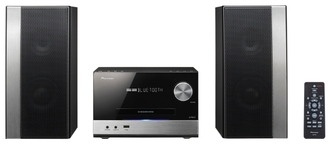 9.2 / 10
Rating
Reviews
Excellent for your money mini-audio system with excellent sound, strict and classic design, appropriate for any furniture and interior. |
|
6 460
In terms of the power of Sony, among microsystems, 6-7 thousand are an obvious outsider: the speakers in total give out only 12 W via RMS. Moreover, despite the use of 80-millimeter speakers, the bass is even smaller than in many active computer speakers, where the speakers are even smaller: of course, you can turn on the built-in “bass booster”, but the sound will not appear serious in the sound, and screen rather amused.
But there is a good bonus for gadget menus: Sony's micro system supports NFC, so connecting smartphones and tablets to it quickly and conveniently. If you have a Walkman player, you can connect it directly to the USB port and play the tracks stored in it, while charging the battery in the player. Main advantages:
Minuses:
|
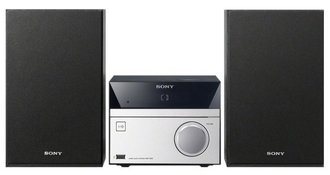 9.0 / 10
Rating
Reviews
Compact and lightweight music center, for the kitchen - the best option. The sound is good, with a smartphone easily connects. |
The best low-cost stereos
|
7 364
The Mystery stereo system easily catches the eye in the window and fits into the interior, although donating protective grills for the sake of design (this was done so as not to block their lighting) was a controversial idea. Unlike other models from the same family and price category (MMK-825U, MMK-930UB), there is no absolutely useless microcrank for watching videos from DVD (in fact, why is this a music center?), But there are no such frequent problems with stop working controls on the front panel, which is structurally much simpler than in these models.DVD player support, however, has been preserved - the music center is equipped with several video outputs of different types, so it can work as a video player paired with a TV, at the same time replacing the built-in speakers with a more decent one.
The declared output power is 2x75 W, but given the low sensitivity of the speakers, this is not so much at an acceptable level of distortion. Of course, you can unscrew the volume for the whole, but the sound will be far from “no ice”. Although lovers of hooting and bumbling bottoms without a special musical ear, it may be suitable. Bluetooth audio transmission is supported, so the MMK-915UB can be considered a full-fledged "universal" for home use. If the budget is limited, and I want more opportunities, then why not? Main advantages:
Minuses:
|
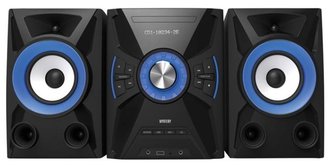 9.5 / 10
Rating
Reviews
Not bad saved - you can listen to music and watch movies. For movies, by the way, the acoustics here are very well suited. |
|
5 940
The music center, if I may say so, has an unconventional orientation: instead of the typical bookshelf format “central unit and speakers” there is a monoblock, all controls are moved up, and there are also carrying handles (and with a weight of 8.5 kg they are not superfluous ). This clearly hints that BBK will not live on the shelf - it’s worth taking with you to the countryside, to the country barbeque, and much more, where you need something more serious than microcolumns connected to the phone.
The fragile optical drive AMS115BT is deprived - for such "road" devices it is rather a plus than a minus. A set of radio, USB-connector for flash drives and Bluetooth will be quite enough, but if you really want to terrify the surroundings with your vocal abilities, then there are already two microphone inputs. I also liked this device by the fact that in the era of all kinds of digitization, touch control and other high-tech there used a manual analog equalizer - no incomprehensible presets for you, but quite real six sliders. It combines perfectly with the general rather brutal style of the device. Main advantages:
Minuses:
|
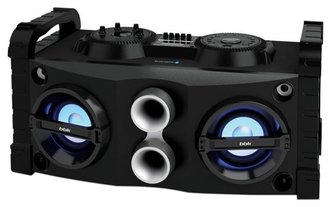 9.4 / 10
Rating
Reviews
Good inexpensive music center. Chose largely because of the design. It is unusual that attracts attention. Manual equalizer - it is really comfortable and again knocked out of the canons. |
|
9 308
One of the few in this price segment of 2.1-inch music centers: in addition to two 25 W RMS speakers, there is also a 40-watt subwoofer. Like the MMK-915UB, this model can also work as a DVD player (and there is also an HDMI output, except for analog), and also has a bonus for a slot for memory cards paired to a USB connector. The case of the central unit and the acoustics here, by the way, of an unconventional type are very thin, so the music center asks for the wall, not the shelf.
However, it is this design of the speakers that makes the MMK-820U play the sound of “classic” music centers and even many high-quality microsystems. The subwoofer is also too small to hit the bottom. But, on the other hand, this model attracts with its compactness and the possibility of mounting on the wall: in a limited space of small rooms it will not be so bad, but the ratio of functionality to price here can be attributed to advantages. In the future, the system can be improved: there is an exit to the active subwoofer “more mature”. Main advantages:
Minuses:
|
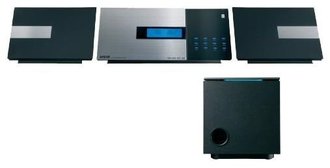 9.2 / 10
Rating
Reviews
It takes up a minimum of space, the acoustics are not the best, but in comparison with the TV speakers it is much better. I'm basically a movie and drive, here and sub in the subject. |
The best middle class stereos
|
21 490
The strict design (although you can’t say so in the yellow-colored version) fits in perfectly with the traditional sound quality of Onkyo. The power of the speakers here is 20 W each, but these are far from the same watts as in cheap systems: the sensitivity of the speakers is not bad, so they actually sound louder than in the music centers of the lower price range. Each speaker is equipped with two speakers - a 100-millimeter mid-tick and a 20-millimeter dome tweeter, and they really sound on the level, although you shouldn’t get carried away with the bass: do not forget that with such treatment with yourself, inevitably one day will wheeze.
Fans of “apple” technology will be attracted by the ability to directly connect iPhone Podopods to a USB port: the music system will correctly recognize them as an audio source, and at the same time charge them. Owners of gadgets on Android fit Bluetooth-connection with the fourth version of the protocol, A2DP and NFC. The only strange thing is that the playback of lossless formats is not supported: the class of acoustics and amplifier would make it far from useless. Main advantages:
Minuses:
|
 9.9 / 10
Rating
|
|
12 980
The design for the music center is no less important than the sound quality, and the compact system from Pioneer came out really one of the best: the vintage look will organically fit into any interior, except frankly high-tech, devoid of screaming notes than many models sin. The music center is small in size and power, but it manages to look solid and expensive at the same time (although, what is there - it really is not so cheap). By the microsystems, it is not possible to attribute it to the language - as a unit it weighs under 6 kilograms, and it will take at least 450 mm in width if the speakers are placed vertically and right next to the “head”.
The power rating of 30 W will cause someone to have a contemptuous “fi”, but this model will have enough volume for most apartments with a margin, and the amplifier and speakers will not begin to supplement each other with distortions and wheezing. You can, of course, complain about the weaker bottoms of a combination of a 100-millimeter mid-frequency and 50-millimeter tweeter, but this is more of an amateur question: many X-CM56-B music genres are more than “in the teeth”. Main advantages:
Minuses:
|
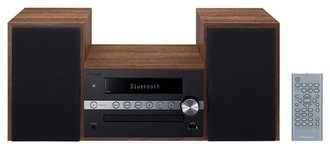 9.7 / 10
Rating
Reviews
The music center is genuinely beautiful, does not hit the backlight. Perfectly creates an atmosphere in the bedroom, if you know what I mean. |
|
9 672
As far as the "Pioneer" was modest, so is the "Phillips" screaming. Even the design of the central unit was made deliberately distinguished, with chopped edges - it looks more like an overgrown car stereo. Columns with "gold" diffusers 120-millimeter speakers trimmed under the carbon.
Comparison with the car radio is involuntarily remembered when evaluating the sound: as much as 230 watts of total power were squeezed out of the stereo system, having already installed two terminal amplifiers, and he clearly likes to use lows. But the two-inch tweeters are not so bad as to openly merge the detailing of the tops - the system allows not only to torment the neighbors at full volume, but also to listen to music for your own pleasure. Well, yes, especially if you are experiencing this pleasure from the suffering of your neighbors - if Onkyo or Pioneer subconsciously asked to include something from Rick Estrin & The Nightcats, then you would like to scroll through the playlist to Impaled Nazarene. Main advantages:
Minuses:
|
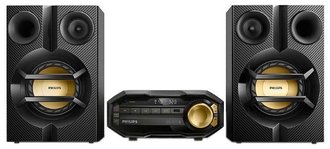 9.2 / 10
Rating
Reviews
For electronics up to the harsch, the EBM is just right, the power is enough for the eyes. |
|
19 620
Cool midisystem for parties.Output power - up to 1000 W (in reality, of course, less, but still impressive)! Of course, to fully disclose the capabilities of the model, it is necessary to connect external acoustics. Own subwoofer can produce up to 500 watts. An optical DVD-drive with the ability to play the entire spectrum of CDs and DVDs - perhaps the little that connects this music center with traditional models. The music harvester has a professional karaoke system, which the manufacturer has equipped with a disc for 2000 songs, a microphone and a songbook. The LG OM7550K can be used as a home theater (there is an HDMI connector, outputs for two additional speakers, as well as an input for connecting an FM radio antenna). Main advantages:
Minuses:
|
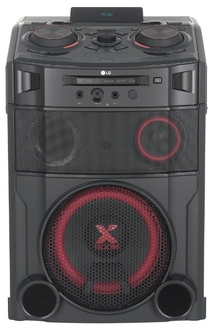 9.0 / 10
Rating
Reviews
Great column! I think for this money the best option. She will shake the hall with a bang! |
The best premium audio systems
|
27 490
Structurally, this two-block music center is closer to AV-receivers, which is hinted at by the possibility to buy only “heads” without complete acoustics. In addition to the standard set of CD player, USB, Bluetooth and analog line input, there are two digital ones - optics and coax.
The system is divided into two units - in one the amplifier is assembled, in the other the actual CD drive and USB input. Although in the standard acoustics there are only two frontal two-strips, the amplifier has an output to the subwoofer - a big plus to the possibility of modernization. However, the standard 120-mm loudspeakers with fiber-optic diffusers work well for low frequencies, they are completely in the teeth of a sharp attack of synthetic bass or concert performers of the bass guitar Lemmy Kilmister. Inch tweeters with soft domes give detailed, neatly smoothed top, the sound they really beautiful. If this is not enough for you - well, it is not for nothing that there is a package without speakers, isn't it? As befits the best high-end audio systems, the power here is not “pontovaya” (measured with 10% non-linear distortion), but “fair” (75 watts per channel with THD 0.7%). So there will be enough volume for everyone, and the sound in the “volume up to the stop” position does not cause the desire to plug ears and quite experienced audiophiles. The main thing is not to tell the lovers of “running in cables” and “gold-plated sockets” that inside here is a class D amplifying cascade, take pity on them. Main advantages:
Minuses:
|
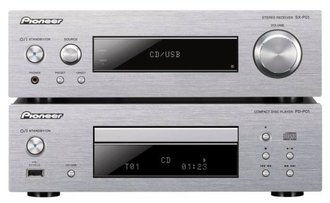 9.8 / 10
Rating
Reviews
Serious sound with standard acoustics, with decent speakers and absolutely beautiful. The best music center, their money is definitely. |
|
24 140
If you need “a lot of sound”, but “plenty of space” in the room is not provided, you should pay attention to the vertical monoblocks, and the Sony MHC-V77DW in this class can be considered one of the leaders.
The 22-kilogram unit has a 250-mm subwoofer, two 120-mm mid-tones and two 40-mm tweeters. Enough and the top, and the power of the bottom, the total power of all channels will allow to arrange a home party or a small open-air. Actually, for this model and created. Judge for yourself: the megacollus can be transported on standard wheels (there is a transport handle), the top panel is dust and moisture protected, two microphones can be connected and even the built-in sound processor for amateur concerting (flanger, vocal isolation, etc.). But, besides, they “shoved” DVD playback (there is an HDMI output to the TV), and the ability to “catch” music from a local network, and distribute it via Wi-Fi to other acoustic devices, and much more. In other words, we have a real wagon, which has many applications, and we will simply tire of the list of all the characteristics. Main advantages:
Minuses:
|
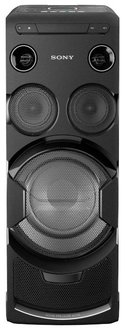 9.3 / 10
Rating
Reviews
The best music center for beach parties and amateur concerts. Five plus for the idea. |
|
27 990
Having upgraded the D-M40 audio center, which is already well-known and deserved positive feedback from the audio press, the Denon engineers did a strange thing, completely depriving the new USB connector model: of course, Bluetooth is well supported here (for the first time in this line) and there is an optical input for a pair of line-in, but still this decision is incomprehensible. Although retrograds from audio equipment, regularly dusting a shelf with a CD collection, this will never upset, well, having connected the “head” to a high-quality sound card using optics, it will be possible to listen with pleasure to your favorite collection of FLAC tracks, which will fit on the flash drive than to hard disk.
The standard acoustics correspond to the class that Denon sets for itself - a standard set for two-strips of this format is a set of 120-mm woofer and 25-mm silk tweeter perfectly balanced by frequency response, there are no tangible dips and peaks in frequencies. The system sounds really tasty, and you can’t take it from her. The amplifier, which is typical, is assembled on discrete elements and works in the AV class: if you are fundamentally turned up by chips, and the mention of class D is like the “flavor” of Swedish superstreme, then Denon obviously took care of you, and the amplifier doesn’t turn into an oven weighing under a centner, as it would be with the A-Class lampovik. Main advantages:
Minuses:
|
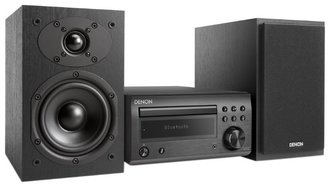 9.3 / 10
Rating
Reviews
I tried to connect here another high-end acoustics, and an external player - which is strange, the sound did not get better, so here even out of the box is an excellent level. |
|
Yamaha’s versatile component system is highly functional. As a data carrier, you can use both CDs and flash drives. For Apple owners, support is provided for AirPlay technology, so music from any Apple device is transmitted without the use of wires. To expand the possibilities of sound, the user can connect to a separate output subwoofer. An interesting feature of the music center is the support of Internet radio. Only the lack of a Wi-Fi module is distressing, which is why the connection to the global web is made only via the Ethernet port, which cannot be called a very convenient solution (there is, however, an opportunity to purchase a special adapter for a wireless network). Output power - 64 watts. Main advantages:
Minuses:
|
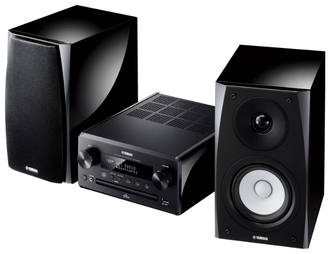 9.1 / 10
Rating
Reviews
What makes me especially happy about this model is that it does not distort the sound, this is how a particular track should play, so it reproduces it. |
How to choose the best music center
Let's start with body format. For background music or a small room will be enough microsystems - but it is worth considering that the small dimensions of the speakers will clearly affect the sound.That is why frankly low-cost microsystems we did not consider: it is easier to connect active speakers with a higher class to the phone than to try to achieve a good sound from cheap models of this class.
Mid-size same mini-systems - now the most popular class of music centers: the dimensions still allow to fit them even into a limited space, but the speakers are already becoming more serious - either a decent mid-range, or full-fledged two bands. Mid systems are not so many - the overall “head” causes problems during installation, and the bundle from the receiver and the bookshelf / floor speakers will still be better than the music center “overgrown” with three-way acoustics.
A separate case is monoblockwhere both the “head” and the dynamics of both channels are installed in the same package. Such systems do not have a good stereo-panorama, but as a portable option for a dacha, attacks on nature or parties in the open air, such devices fit perfectly, which is also taken into account by the designers, who “honed” monoblocks for just such an application.
Playback options By the standards of the end of the 2010s, they should at least imply audio playback via Bluetooth and USB media: these methods are most convenient, but if DVD playback is provided, then this is excellent. For high-end models, not only full integration with the “apple” technique became the norm, but also the functionality at the receiver level: LAN connection, optical inputs, and so on. As a matter of fact, the class of musical centers itself is increasingly turning from independent into a set of “receiver + speakers”.
But what exactly you should not strive for is watts: many-digit numbers are meaningless when measuring by RMS (you can definitely listen to music with 10% non-linear distortion in sound), and with the sensitivity of speakers on an inexpensive technique: where cheap dynamics will have to be switched on under 40 W of electrical power, good acoustics the same volume will give at 10 watts.
Have a good shopping!
